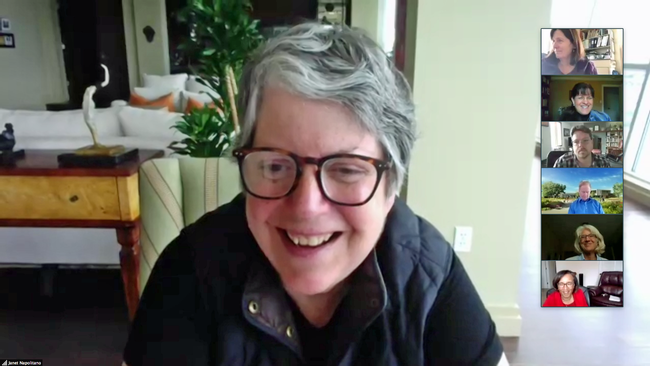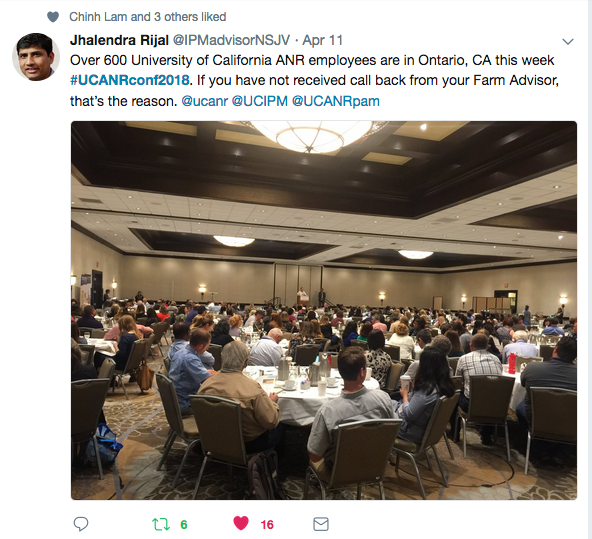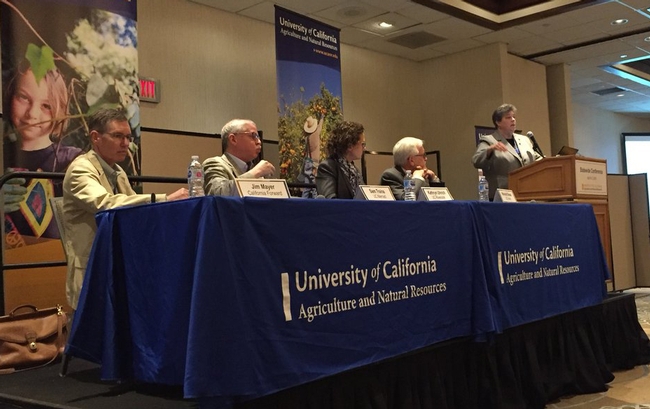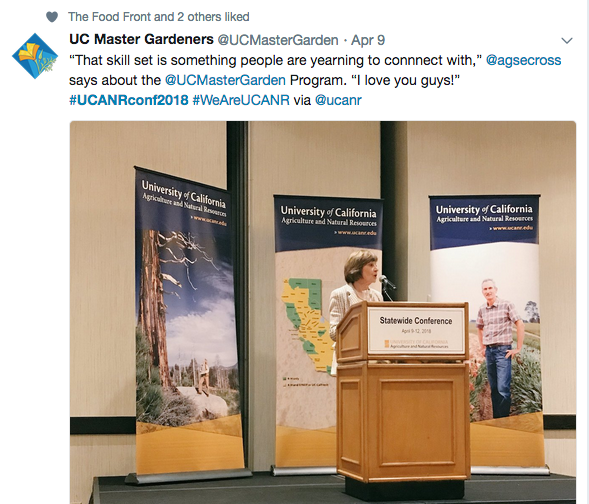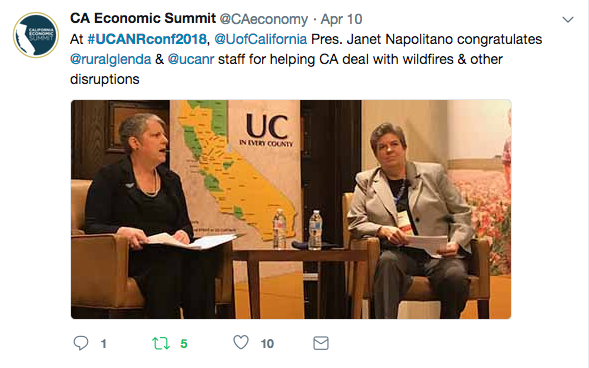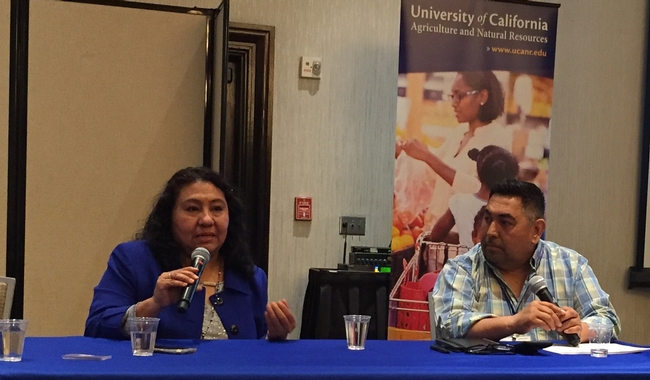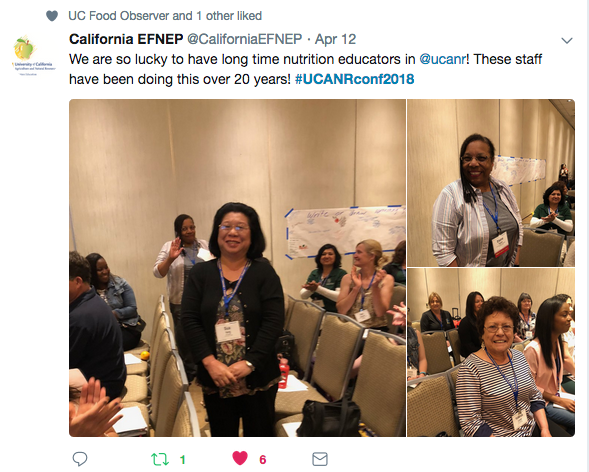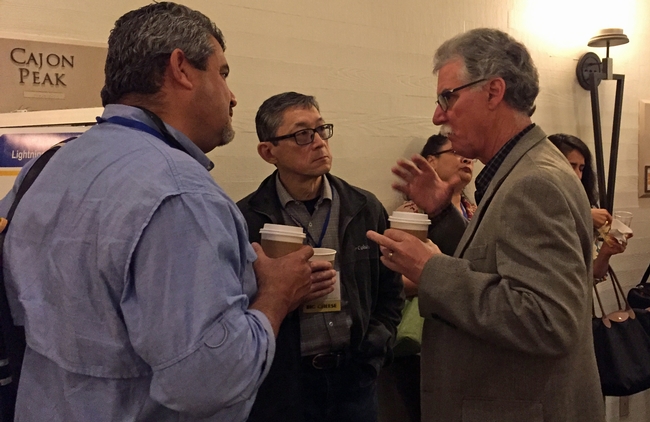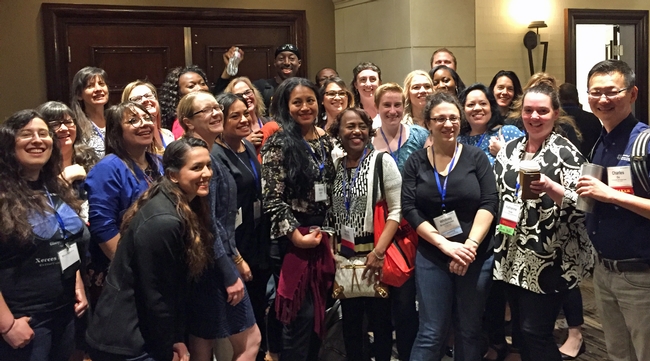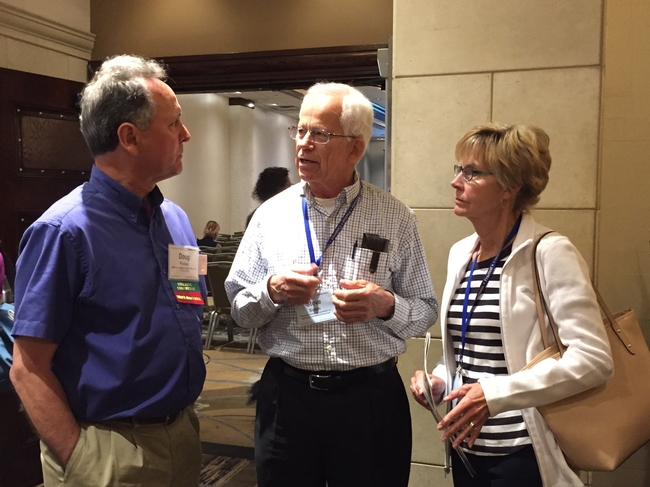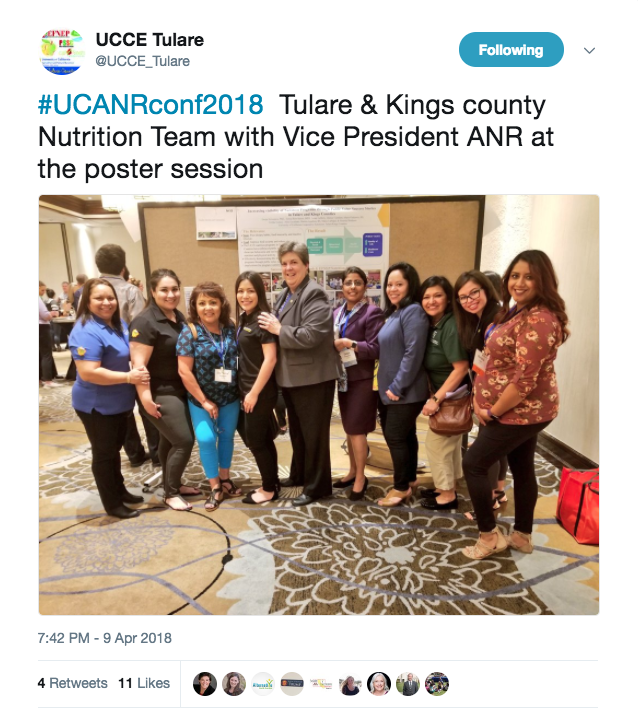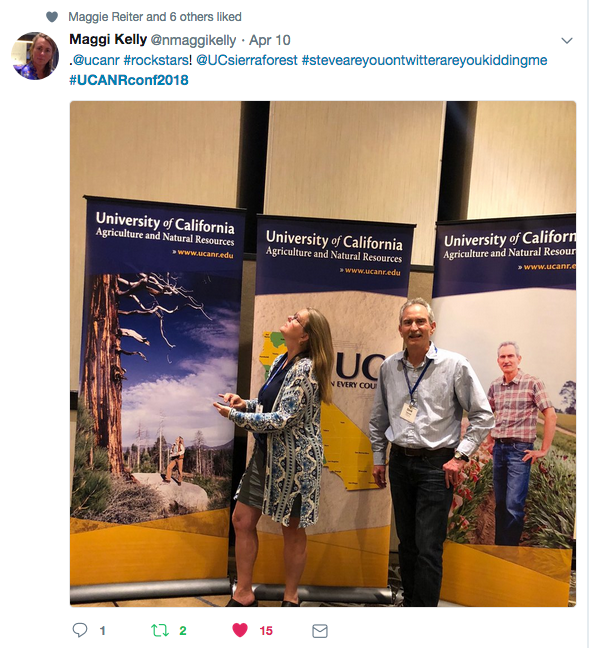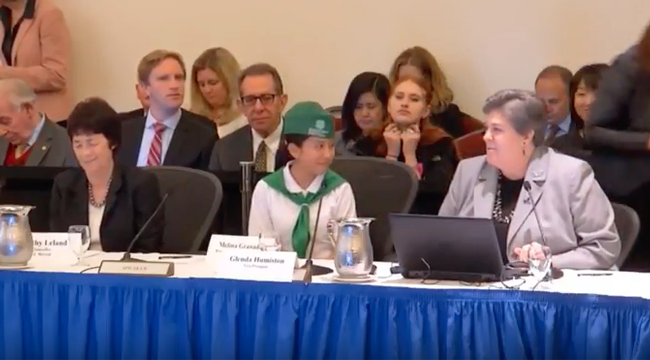Posts Tagged: Janet Napolitano
PAC meets virtually, thanks President Napolitano for her service
The President's Advisory Commission on Agriculture and Natural Resources met via Zoom April 9 as everyone was sheltering in place during the coronavirus pandemic. Jean-Mari Peltier, PAC chair, welcomed the PAC members for their last meeting with President Janet Napolitano. Last September, Napolitano announced that she will step down as UC's leader Aug. 1.
President Napolitano commended ANR for its flexibility in response to the COVID-19 crisis. ANR is “the University of California for large parts of the state and we're proud that you are,” she told VP Glenda Humiston, adding that ANR is performing well under her leadership.
Napolitano thanked the PAC members for contributing their time and advice during her seven years at the UC helm, calling ANR “essential to UC identity as land grant university.” The commissioners thanked the president for her support for ANR. In response to questions about building support for ANR with her successor, Napolitano recommended taking the new president out of Oakland for site visits to learn about ANR. She described her visits to Kearney Agricultural Research and Extension Center, Humboldt County and other ANR sites as “eye opening.”
In her update about ANR, Humiston reported that despite the coronavirus pandemic's disruption to public gatherings, all ANR programs are still serving communities. “I'm really impressed with the innovative ways they are finding to deliver outreach,” she said, adding that advisors are adapting, for example, doing ranch visits via phone. Humiston also described the UC ANR Governing Council's tour of the South Coast Research and Extension Center in February to see how ANR engages urban Californians. She noted that a regents tour of South Coast REC planned for April 23 has been postponed until after the pandemic passes.
Karen Ross, secretary of California Department of Food and Agriculture, joined the group to discuss how CDFA is responding to food system disruption resulting from the COVID-19 crisis. “I am optimistic about agriculture; we are so innovative and resilient,” Ross said, adding that she is concerned about funding for UC ANR and UCCE. She recommended seizing the moment while consumers are thinking about the food system to educate people about UC ANR's role.
Building on their December meeting, the PAC members continued their discussion of the future of the commission. They discussed recommendations to ensure the success and sustainability of ANR as well as the PAC.
They recommended the role of PAC members include
- Communication & advocacy
- Engaging as a strategic tool for problem solving
- Being a connector to industry leaders
- Supporting fund development
- Advising on strategy and mission priorities
To make their membership meaningful, the commissioners said they would like
- Greater active involvement
- Knowing they add value
- Feeling connected with ANR and other PAC members
- Sharing critical information
Although the PAC usually meets twice a year – in the spring and fall – the PAC agreed to meet again via videoconference in May or June to discuss and approve the new PAC charter.
ANR exchanges ideas, creates new collaborations in Ontario
“I don't know about you, but I'm really excited to have this gathering,” VP Glenda Humiston said, as she greeted the people attending the 2018 ANR Statewide Conference in Ontario. More than 650 people participated in the conference held April 9-12 at the DoubleTree by Hilton Hotel Ontario Airport. Humiston noted it was the first time since 2013 that all ANR employees had been invited to meet with their colleagues in person and discuss their work.
There were keynote presentations, science sessions, trainings, program team and workgroup meetings, numerous breakout sessions to attend, puzzles to solve in the resource room, a pop-up studio for News and Information Outreach in Spanish interviews and dozens of research posters to read. ANR leaders discussed how to chart a sustainable future for ANR. Wendell Brase, UC Irvine associate chancellor for sustainability; Sam Traina, UC Merced vice chancellor of research and economic development; and Kathryn Uhrich, UC Riverside dean of the College of Natural and Agricultural Sciences, whose research has spawned start-up companies, discussed opportunities for innovation. Wendy Powers, associate vice president, announced the winners of the Distinguished Service Awards.
And in between, there was time to network with colleagues over meals and in the hallways.
ANR partners also joined the event, including members of the UC President's Advisory Commission on Agriculture and Natural Resources.
Great partnerships
“Think about what California's agriculture would be like without Cooperative Extension,” said California Department of Food and Agriculture Secretary Karen Ross, ex-officio PAC member and keynote speaker for the first day. “It doesn't just happen because of great farmers. It happens because of great partnerships. ANR is in every county.”
“I cannot tell you enough, what an asset you are to this state and to the industry that I love, agriculture, and to every consumer who has the joy of imbibing in our beverages and foods that come from these marvelous lands.”
Unique role in UC
On Tuesday afternoon, UC President Janet Napolitano joined the group. She called out ANR's work in climate change adaptation, agricultural innovation, food systems, food security, and nutrition education and noted the unique role it serves in advancing UC's Global Food, Carbon Neutrality, UC-Mexico initiatives.
She lauded 4-H for achieving parity in Latino youth participation in its programs, saying, “I think that says a lot about ANR's values and the impact it can have.”
Praising UCCE's outreach to economically disadvantaged Californians, the president said, “I'm going to continue to fight hard for funding for these programs at the federal level.”
Napolitano said she was pleased with the overall federal budget, noting that Congress increased funding for the National Institutes for Health and the National Science Foundation. “The University of California gets more NIH and NSF funding than any other university in the country. Almost 10 percent of the NIH research budget comes to the University of California so we have a lot at stake in those federal funds.”
For updates on UC's state and federal budgets, Napolitano urged everyone to sign up at https://www.universityofcalifornia.edu/support-uc/ucan.
On the Huron report recommendations for moving ANR out of the Office of the President's structure, Napolitano said she has appointed a committee to review the options and offer its own recommendations before the November regents meeting.
Building pathways
The crowd was inspired by Antwi Akom, UC San Francisco and San Francisco State University professor and founding director of Social Innovation and Urban Opportunity Lab (SOUL) and co-founder and CEO of Streetwyze. In his presentation “Race, Space, Place and Waste: How Innovation, Education, and Inspiration Can Fearlessly Catalyze California Towards Becoming the World's Leader in Agriculture and Natural Resources Management,” Akom spoke passionately about building more pathways for a more diverse array of Californians to participate in ANR programs.
“That's the first time I've seen members of the audience follow a keynote speaker out of the room,” Mark Bell, vice provost for Strategic Initiatives and Statewide Programs, later commented on the rock star treatment Akom received after his talk.
No layoffs
In her closing comments of the conference, Humiston said, “It was heartwarming to hear so many people tell legislators that ANR programs are important to them,” at the California Farm Bill hearing April 11 in Sacramento. If approved, the bill introduced by Assemblymember Anna Caballero (D-Salinas) would enable ANR to hire 45 more UCCE advisors and would offer incentives to adopt agricultural technology.
Concerning UC's budget challenges, Humiston said ANR is facing reductions in funding that will be absorbed through a slowdown in hiring and other means.
“There will be no layoffs. I took this job to grow ANR not shrink it,” she said emphatically. “The more the people of California understand what ANR does, the more they want us to thrive and be in place to better serve their needs.”
Humiston declared the conference productive and successful and thanked the Strategic Initiative leaders and conference and steering committee for planning the event and the Program Support Unit and volunteers for their hard work.
Doug Parker, Water SI, and Keith Nathaniel, Healthy Families and Communities SI, were the executive co-chairs and David Doll, Sustainable Food Systems; John Harper, Sustainable Natural Ecosystems; and Cheryl Wilen, Endemic and Invasive Pests and Diseases, were co-chairs.
The steering committee was composed of Michael Anderson, College of Natural and Agricultural Sciences, UC Riverside; Mark Bell, Strategic Initiatives and Statewide Programs/Institutes; Sherry Cooper, Program Support Unit; John Fox, Human Resources; Chris Greer, UCCE San Luis Obispo, Santa Barbara and Ventura counties; Brad Hanson, Department of Plant Sciences, UC Davis; Darren Haver, South Coast Research and Extension Center and UCCE Orange County; Mike Janes, Strategic Communications; Maggi Kelly, Informatics and Geographic Information Systems and UC Berkeley; Neil McRoberts, Department of Plant Pathology, UC Davis; Katie Panarella, Nutrition, Family and Consumer Sciences Program and Policy; Maurice Pitesky, School of Veterinary Medicine, UC Davis; Joni Rippee, Program Planning and Evaluation; Rachel Surls, UCCE Los Angeles County; and Patti Wooten-Swanson, UCCE San Diego County.
ANR leadership plans to host the next ANR Statewide Conference in 2021.
Continue the conversations
To see snapshots from the conference on Twitter, search for the hashtag #UCANRconf2018.
If you missed the poster sessions, most of the project posters can be seen by clicking on the title links at http://ucanr.edu/sites/statewideconference2018/Posters_and_Displays.
“I've heard great things about a number of the sessions and have been discussing some follow-up ideas to build on concepts covered during some of those sessions,” Wendy Powers wrote in her ANR Adventures blog. “It would be a disappointment if we all left the meeting, got caught up in our obligations and programs, and didn't continue the conversations.”
President Napolitano analyzes options for ANR in UCOP structure
Dear Colleagues,
In my ANR Update message on Feb. 8, I shared a report released in January by the Huron Consulting Group on the UC Office of the President's (UCOP) organizational structure. President Napolitano's goal in commissioning that review was to improve the effectiveness and efficiency of UCOP, while aligning its work to best support the university's core mission.
As I mentioned last month, Huron offered options that we believe would harm ANR's ability to deliver our mission of research and extension and to bring UC to local communities in every part of California. We identified several issues with both options, chief among those were adding layers of administration between ANR and the UC president as well as between ANR and the public we serve. Those additional layers would likely increase administrative costs and reduce funding for program delivery. At the president's request, we have developed an alternative proposal that would strengthen ANR's ability to deliver our mission while also serving the needs of UCOP for better financial management and administrative efficiency.
A challenge we have faced for years is that about half of our budget flows through UCOP while we manage the remainder directly. ANR is the only major operating division at UCOP that directly conducts research and program delivery, with hundreds of employees throughout California deploying over $200 million in resources. This has caused a great deal of confusion for auditors and often led to budget cuts during calls to reduce UC administrative overhead. Our recommendation places the entire ANR budget into one operating unit/location within the UC Chart of Accounts and allows for more transparency to the public. It also improves ANR's opportunities to stabilize our funding, rebuild our academic footprint and enhance program delivery.
Unlike the institutions used as examples in Huron's report, there is no one flagship campus serving as California's land-grant institution; instead, the entire UC system is responsible for the land-grant mission. To effectively deliver that mission, ANR is structured as a large statewide operating unit administering over 300 Memoranda of Understanding with a wide array of public and private sector partners, including deployment of resources on multiple campuses across the UC system and in close partnership with local governments in every county. The Huron report recognized that housing ANR within one campus was suboptimal and could create perceptions of favoritism and inequities between the campuses. Our proposal calls for a collaborative relationship; injecting competition and administrative layers would not serve the UC system nor our stakeholders well.
Separating ANR's budget and FTE from UCOP offers many advantages to both entities. Under the proposal we have offered, the ANR vice president continues to report directly to the president, the ANR governance structure does not change and no people or infrastructure would be moved. The proposal does agree with the Huron recommendation that ANR funding should be changed to state appropriations and that reconnecting the UC Natural Reserve System to ANR offers improved research opportunities for both entities. We believe these changes would best achieve the president's objectives to better align UCOP support functions to campuses while enhancing the systemwide and statewide functions of a vital outreach and engagement arm of the university.
The president continues to analyze the different options before her to ensure UCOP is best serving the UC system as well as all Californians for the long term. We are excited to work closely with President Napolitano to strengthen UC as a premiere research and extension institute by giving these vital programs room to grow and better serve the critical needs of California's economy and communities. I will continue to keep you apprised as our discussions unfold.
Glenda Humiston
Vice President
UC Merced chancellor, 4-H’er and VP discuss community outreach with regents
UC VP Glenda Humiston, 4-H member Melina Granados of Riverside County and UC Merced Chancellor Dorothy Leland gave the UC regents a presentation about UC ANR's community outreach and impact. The Public Engagement & Development Committee meeting was held at the UCSF–Mission Bay Conference Center on Jan. 24, 2018, in San Francisco.
Opening the discussion, Humiston gave an overview of ANR, explaining that for 150 years ANR has been bringing the power of UC directly to the people in all California counties. Melina, who was born in Mexico, talked about her role as president of the Eastside Eagles 4-H club and what she has learned. Leland described joint projects between UC Merced and ANR in climate adaptation, nutrition and drone technology research.
Watch the 25-minute recording of the UC ANR presentation to the regents below, or visit https://youtu.be/ptFS8HwlsjE.
AI can help growers more precisely manage their fields, Humiston tells Little Hoover Commission
Artificial intelligence, or AI, can improve precision agriculture by using sensed environmental data to “learn” and continually adapt, VP Glenda Humiston told the Little Hoover Commission at a hearing in Sacramento on Jan. 25.
The Little Hoover Commission is reviewing the impacts of artificial intelligence. While there is no singular definition, artificial intelligence encompasses a broad range of technologies that seek to approximate some aspect of human intelligence or behavior.
Throughout its study, the commission will consider the potential policy role of California state government in areas such as regulation, workforce development and retraining.
Humiston was asked to give a statement on the impacts of artificial intelligence in the agricultural sector.
“California's working landscapes face some critical challenges; among those are drought, climate change, air quality, soil health, pests, pathogens and invasive species,” she said. “Additionally, rural/urban conflicts and urban sprawl continue to reduce available farm land and make viability of food production more difficult.
“Of importance to today's hearing, California's labor-intensive crops are facing increasing difficulty accessing necessary labor – both skilled and unskilled. This situation has led growers and universities to seek solutions through mechanization, automation and other new technologies.”
She sees opportunities in precision agriculture for growers and ranchers to more precisely manage their operations by using site- and crop-specific data gathered by new technologies.
“Artificial intelligence improves this further by using the sensed environmental data to ‘learn' and continually adapt to ever-changing conditions as it receives data that strengthens the computer's ‘intelligence,'” she said.
Humiston also outlined some of the challenges to harnessing the power of AI for agriculture.
“Artificial intelligence is extremely difficult in agriculture because of the huge amount of variability in environmental conditions across a single field,” she said. “This requires many sensors, complex algorithms, and large real-time data processing – all integrated and working together to inform decisions and actions.”
In a 2014 Pew Research Center survey, the vast majority of the 1,896 experts anticipated that robotics and artificial intelligence will “permeate wide segments of daily life by 2025.” The commission's artificial intelligence project will investigate the shape and speed of these changes in California and in society.
Through its public process, the commission intends to study the key challenges of artificial intelligence in California, its economic implications and how it can be used to solve societal ills. The commission will review issues such as justice, equity, safety and privacy. The project will consider recent studies on workforce impacts, which could include both job creation and job displacement. Possible mitigations and worker protections will be discussed as will examples of efforts to plan and prepare for innovations and labor transformations.
To read Humiston's full testimony to the Little Hoover Commission, visit http://www.lhc.ca.gov/sites/lhc.ca.gov/files/CurrentStudies/ArtificialIntelligence/WrittenTestimony/HumistonJan2018.pdf.

